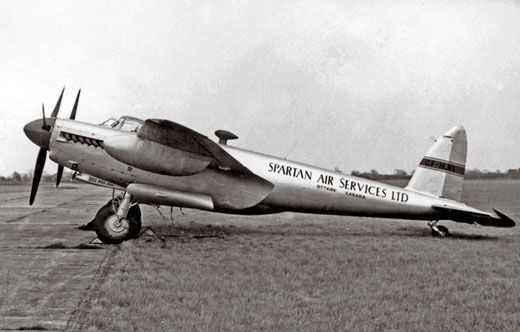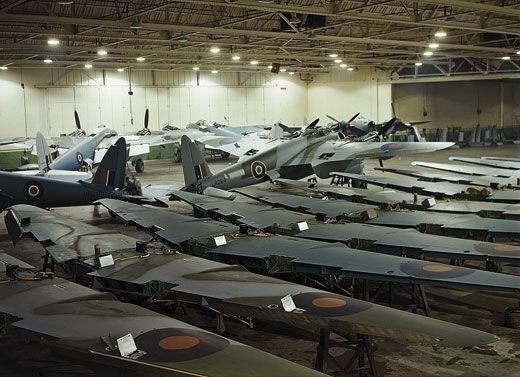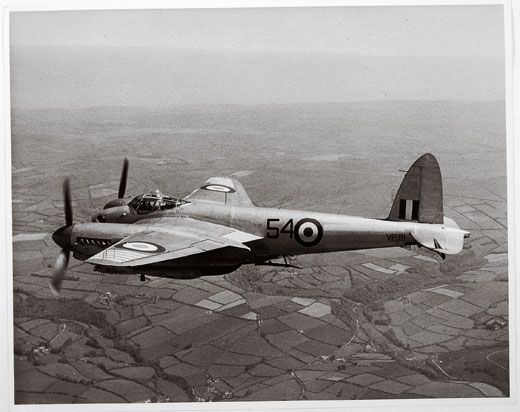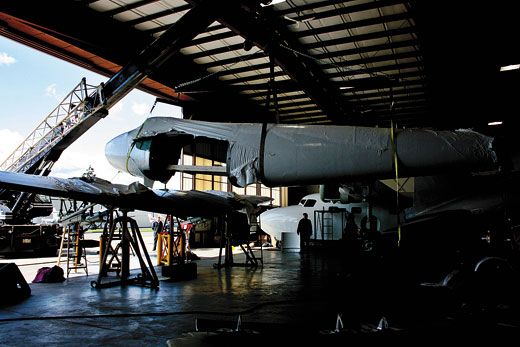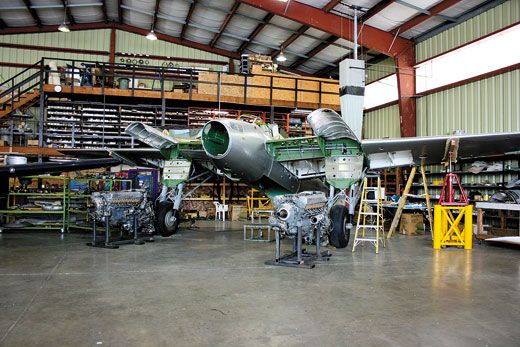Restoration: Carpenter’s Special
De Havilland D.H.98 Mosquito
/https://tf-cmsv2-smithsonianmag-media.s3.amazonaws.com/filer/Restoration-Mosquito-worker-2-flash-631.jpg)
Conceived as a light bomber, the World War II de Havilland Mosquito was designed to defend itself with its 400-mph speed rather than with guns. De Havilland eliminated armament to save weight, and because Britain’s supply of aluminum was limited, built the aircraft of wood. In the process, Britain’s war effort came to involve cabinet and furniture makers, carpenters, and piano builders.
The Royal Air Force—and the British government—were skeptical of de Havilland’s ambitions, but within a year the company built a prototype D.H.98 in a hangar disguised as a barn. On November 25, 1940, serial number W4050 made its first flight. Bomber Command’s fastest airplane went on to equip some 100 RAF and five Royal Navy squadrons, and dozens of other countries’ forces, including the U.S. Army Air Forces. De Havilland eventually produced 7,781 D.H.98s.
The world’s last airworthy Mosquito crashed in England in 1996, but the type may fly again soon. A Canadian-built Mosquito under restoration at Ardmore Airfield in New Zealand is close to completion and may fly before the year is out. And next year, one of the last Mosquitos produced should fly in British Columbia, Canada.
Perhaps the first airborne multi-tasker, the Mosquito served as a bomber, fighter, fighter-bomber (both armed), torpedo-bomber, night fighter, high-altitude photo-reconnaissance platform, and early electronic-countermeasures aircraft. The wings were one-piece spruce and plywood, screwed and glued; the fuselage was balsa sandwiched between plywood layers—the same principle as in today’s composite structures. Cockpit space was tight: The manual on parachute drills notes “Should the navigator find it difficult to pass through the exit, the pilot should assist by giving him a good push with his foot.”
The Mk.35 Mosquito at Victoria Air Maintenance in North Saanich, British Columbia, never saw active service. Built after the war, it went directly into storage. In 1954, it was purchased by Spartan Air Services of Ottawa as one of a batch of 10 and given the civil registration CF-HML. During World War II, many Mk.35s had been converted to photo-reconnaissance aircraft, and their high speed, 43,500-foot ceiling, and enlarged bomb bay was just what Spartan needed. The Mk.35 Mosquito flew until 1963, mapping northern Canada, says Mike Ingram, president of Victoria Air Maintenance. “They operated from northern Defense Early Warning line sites like Resolute and Churchill.”
Disassembled by the Royal Canadian Air Force in 1966, CF-HML was purchased by Don Campbell, who intended to make it airworthy again. He had it trucked to Kapuskasing Airport in northern Ontario to teach Air Cadets aircraft construction and maintenance. But by 1979, the airplane had been sold to Ed Zalesky. Restoration resumed, but the pace dragged. In 2005, Zalesky approached Robert Jens, owner of the Million Air corporate aviation service franchise at Vancouver International Airport, who already had a Spitfire Mk.14E. “This Mosquito was out in Surrey in his hangar,” says Jens. “I had some maintenance people inspect it and they felt it was in good condition.” Having previously labored on a P-51, Jens initially worked on the aircraft himself, but “I thought it would never get finished,” he says, “and I felt an obligation to do so. I decided to let Victoria Air Maintenance do final assembly.”
The original Rolls-Royce Merlin engines were overhauled by Vintage V12s in Tehachapi, California. Certification and testing of the airplane are expected next spring, and first flight before summer. “I’ll probably ride in it but I won’t fly it,” Jens says. Insurance rates may dictate what Jens ends up doing with the aircraft.
One D.H.98 that will never fly again is the prototype, now being restored. It’s just too valuable, says Bob Glasby, manager of Mosquito restorations at de Havilland’s Aircraft Heritage Centre in Hertfordshire. It was flown aggressively to test Merlin engine variants. “The aircraft was grounded when it was noted that one of the engines was moving up and down at the spinner by six inches,” says Glasby. When the restoration is complete, W4050 will remain on display at de Havilland.
A graduate of the U.S. Naval Test Pilot School, freelance writer Graham Chandler lives in relatively mosquito-free Calgary, Alberta, Canada.
